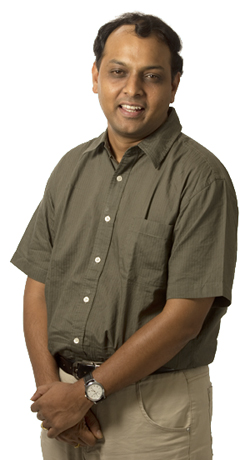Highlights
Researchers welcome new proofs of the quantum substate theorem

New approaches to proving the ten-year-old quantum substate theorem have raised interest thanks to the theorem's wide impact.
The new proofs of the quantum susbstate theorem, which makes a statement about the 'relative entropy' of two quantum states, are "much simpler and more intuitive" than the original says CQT Principal Investigator Rahul Jain (pictured right). He and Ashwin Nayak of the Institute for Quantum Computing in Waterloo, Canada, have published their re-proofs in the respected journal IEEE Transactions on Information Theory.
The quantum substate theorem was originally formulated and proven by Rahul and two other colleagues in 2002. The theorem connects two important measures of a pair of quantum states — the relative entropy and smooth relative min entropy. These measures quantify the similarity of, or in the language of quantum mechanics, the distance between, two quantum states.
In many applications, the more helpful measure of distance is the smooth relative min entropy. When this measure is small, it is possible to express one of the two quantum states as a 'large' substate of the other — a useful trick in calculations. The quantum substate theorem showed that the relative entropy, often the more easily calculated measure, is an upper bound to the smooth relative min entropy (times the smoothness parameter epsilon). The theorem therefore clarifies which cases can be expressed as nice substates.
The quantum substate theorem has since been applied in a variety of scenarios, both quantum and classical. Examples include evaluating privacy trade-offs in communication protocols, studying message compression in classical and quantum communication, analysis of string-commitment protocols in cryptography and determining the communication required for remotely preparing quantum states. For researchers who make use of the quantum substate theorem, the more intuitive proofs are welcome.
As well as being simpler, the new working slightly improves the bound. "In applications so far our improvements in parameters are not so crucial, but maybe in future applications they will be," says Rahul.
The ten-year interlude between proofs does not mean the new work was a ten-year effort. It is an example of the successful application of 'duality theory' in quantum computation and quantum information. There are two new proofs: one is based on minimax duality and the other on semi-definite programming duality. The project to prove afresh the theorem began during a visit by Ashwin to CQT, continued when Rahul visited IQC and was completed, says Rahul, with assistance from Skype.
For more details see "A short proof of the quantum substate theorem", IEEE. Trans. Inf. Theory doi:10.1109/TIT.2012.2184522 (2012); arXiv:1103.6067.






